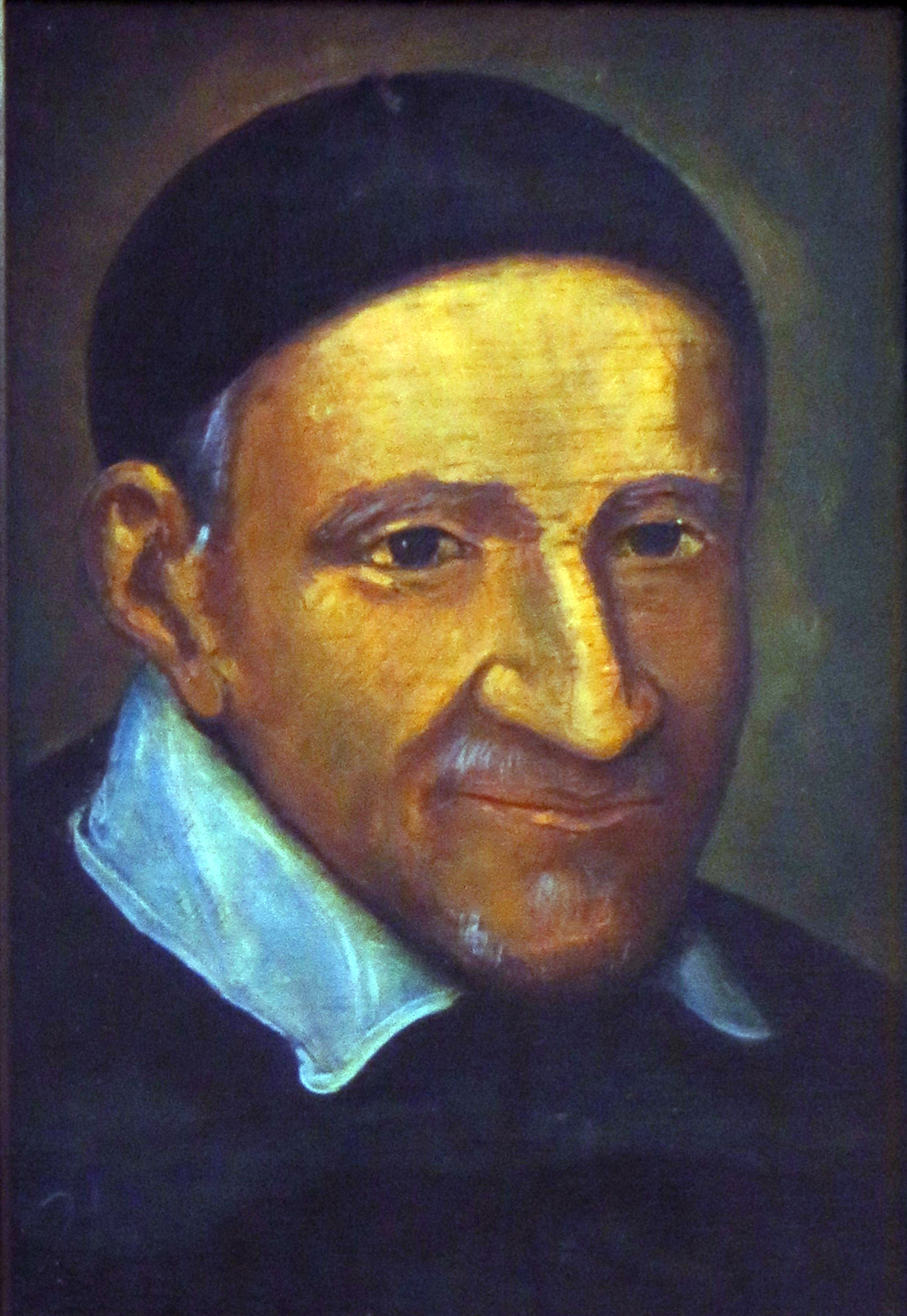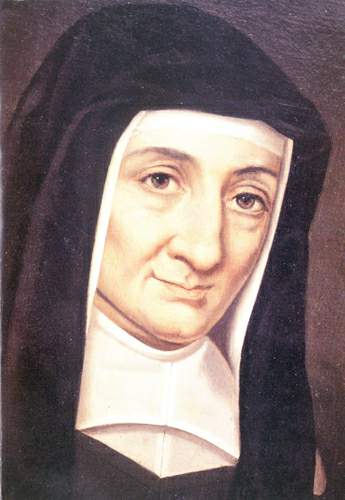Saint Vincent de Paul (1581 – 1660)

Vincent de Paul was born in the small town of Pouy in southern France, on April 24, 1581. He was the third of six children of the couple Jean de Paul and Bertrande de Moras, a peasant couple of firm and vigorous faith. He stood out for his intelligence and religious zeal.
Noticing his ability for studies, his parents invested their scarce resources in his education wishing that this would turn out to be a profitable career to Vincent and the parents could also enjoy it. This ambition, typical of the ecclesiastic conjuncture of the time, was what initially motivated his intellectual application and his entry to the ecclesiastic environment
He began his studies in the city of Dax, where later he became a teacher. However, there was also a genuine religious spirit in Vincent de Paul as well as a sincere attraction to the ordained ministry.
He studied Theology at the University of Toulouse. On September 23rd 1600, at only 19 years old, he was ordained a priest. But the first 12 years of his priestly life were marked by many difficulties and misunderstandings.
The first ordeal occurred when a widowed lady, who liked to hear him preach, left him an inheritance. The large amount of money was in the possession of a merchant in the city of Marseille and Father Vincent went there by boat to get it. Upon his return with the intention of sharing the inheritance with the poor, he was captured by pirates and sold as a slave in Tunis, North Africa and remaining there for two years.
After being kept by four slave owners, he manages to convert the last one, who was a Muslim, and together they escape back to France.
In 1608, in Paris, he met Pierre de Bérulle, an Oratorian priest and future cardinal, whose congregation aimed the reform of the clergy, in order to to get back its authority. Father Vincent takes part in the activities of the Oratory, devoting himself to read spiritual authors, and strives to know better God’s purposes for him. With Berulle’s help, he is appointed chaplain to Queen Marguerite of Valois, taking on the task of distributing alms and visiting sick people in hospitals.
In 1612 he was appointed parish priest of Clichy, a position he held with praise for two years. Then Father de Bérulle entrusted him another mission: educating the Count of Gondi’s children, one of the most influential families in France. For that, Vincent went to live in the family’s castle, in the city of Folleville.
The origins of the Vincentian Charism) – besides the education of the three children of the couple Margaret Mary and François Manoel, Father Vincent was responsible for the spiritual and pastoral care of the more than seven thousand people, who lived in various of Gondi properties, spread throughout France. During his visits to the peasants he closely felt the spiritual and material misery of the poor people of the countryside and there he started his missions. He experienced more joy in speaking about God to the peasants than living in Gondi’s castle, and so he secretly left the castle of Folleville.
In August 1617 he was named pastor of Châtillon-les-Dombes. On a Sunday, August 20th, while preparing to preach at a mass, Vincent was informed that a family in the community was ill and all its members are unable to take care of each other. Taking pity on this situation, he exhorts his parishioners to do something for these brothers and sisters in his homily.
The response (surprised him: the ladies of the community got together, organized provisions and took them to the family. As he was heading to see the sick family, on the same day, Father Vincent figured out: “This is great charity, but it is disorganized. Moreover, it´s necessary that the solidarity of a single day might be present on everyday attitudes and structures.”
From this experience came the Confraternities of Charity, formed by wealthy ladies who gave some of their time and resources to attend the poor. This was Vincent de Paul’s first foundation, that was gathered for the first time, on August 23rd and officially created on December 8th, 1617. The confraternities spread rapidly throughout France.
The experiences in Folleville and in Châtillon-les Dombes led Father Vincent to conclude that the task of the church is not only to look after the spirit. There isn’t possible evangelization without solutions to the situations of injustice and misery. Therefore, it is needed to look after the man as a whole: body and soul.
In 1625, Father Vincent founded the Mission’s Congregation to form missionaries mainly designed to evangelize the people of the countryside and then he met Luisa de Marillac. Widowed and aristocrat, Luisa started helping him with the confraternities work. In 1633 they found the Daughters of Charity Company to serve the poor people, in their body and spirit.
Vincent de Paul died in September 27th, 1660 in Paris, at the age of 79, exceeding life expectation of that time. His remains rest in the Chapel House of Mission’s Congregation. His heart is exposed in one reliquary in the Chapel of Apparitions at Mother’s House of the Daughters of Charity.
According to Saint Francis de Sales, Vincent de Paul was the holiest priest of that time. His canonization took place in June 1737. In May 1885 the Pope Leo XIII declares (announced) him The Patron of Charity Works of the Roman Catholic Apostolic Church.
Saint Louise de Marillac (1591-1660)

Louise de Marillac was born in Le Meux, on August 12, 1591. She was daughter of Louis de Marillac, a French nobleman, knight and the King’s company commander. Nevertheless, her noble bloodline was not a source of privileges and facilities. Her childhood was marked by family mismatches and deprivation, particularly due to lack of presence and affection.
In 1595 she was taken to the Dominican Sisters’ Convent in Poissy by her father. There, she started reading and writing building a solid education based on a human, intellectual, spiritual and artistic point of view, which was of great value, later on her mission with the Sisters and the poor. Her health required permanent care due to her small and fragile physical constitution. The character, however, was of a strong girl, even though a bit introspective, but showing unique depth and remarkable contemplative sense.
When Louis de Marillac died, Michel de Marillac, the Chancellor of France, became Louise’s tutor. He placed her in a girls’ home in Paris. At the age of 13, Louise began attending the Capuchin Daughters of the Cross Nun Monastery, where she took her vows to serve God and the poor feeling that this was her true vocation.
It was her desire to enter the Capuchin convent known by its austerity and strict ways of life and highly devoted to penance and prayer. Her first request, however, was refused by the superior of the order on the grounds of her physical weakness and with the consoling words that “God was preparing her for another experience”.
Michel de Marillac then decided to marry her to Queen Mother Marie de Medici’s secretary of the ordinance. Thus, in 1613, at the age of 22, Louise marries Antoine Le Gras and soon true love arose between them. In that same year, Michel was born, a boy with slow cognitive development, which was reason of great concern.
Between 1621 and 1622, Antonio Le Gras got ill and due to that, short tempered, unbalancing the family’s structure. Le Gras’ illness was a period of intense questioning for Louise.
She questioned herself whether she should leave the sick husband behind and fulfil her consecration vows. She sees in this situation a cross, a punishment for having violated her vows to become a Capuchin nun and falls into deep darkness of spirit.
On a Pentecost’s day, that year dated June 4, during a prayer at the Church of Saint Nicholas Fields, Louise was blessed with a grace from the Holy Spirit. Her spirit was enlightened and her pains and sorrows vanished. She understood that, for the moment, her place was next to her husband until his death, and along with her son until the time to take him to nobles’ children lodges, where he would be well cared and educated. Only after it all she would be able to fulfil her vocation, helping those most in need. Louise also felt that she would find a new spiritual director, which would happen later, when she met Father Vincent de Paul.
In 1623, after becoming a widow, Louise de Marillac placed her son Michel in a lodge for noble descendants’ children in Saint-Nicolas. In 1625 Pierre Camus, the bishop of Belley, appointed Vincent de Paul to take Louise’s spiritual care. Due to their marked personality differences, the initial encounter between Louise and Vincent wasn’t at first that enthusiastic. Louise’s refined and well- educated style and being raised in a wealthy environment, struggled against the rustic and practical sense of Father Vincent, whose life and action had already been touched and transformed by the encounter with the poor.
But very soon Father Vincent led her to the paths of charity. Louise started working with him at the Ladies of Charity and soon was appointed as an inspector of the houses of charity. It was, however, a relationship based on mutual support and cooperation: Vincent was an instrument of God helping Louise to break down the barriers of her own insecurities. She, in turn, contributed with her multiple both human and spiritual gifts, to organize, enlarge and qualify the work of charity which was started by Vincent.
On November 29, 1633, Louise and Father Vincent started the Company of the Daughters of Charity. They also managed to get the Pope’s approval for that congregation in 1655. Louise and Father Vincent intensified their work by helping abandoned children, giving aid to the 30 Year War victims, caring for the mentally ill, and participating in the creation of the Holy Jesus Name and the Paris General Hospital.
The mutual exchange of human and spiritual values between Vincent de Paul and Louise de Marillac built the Vincentian Charism. It would not be honest to the Charism to place Louise with a second-rate participation and importance.
There is a relationship of equity and complementarity both with regard to friendship between Vincent de Paul and Louise de Marillac and in the cooperation for the development of the work they undertook.
Louise de Marillac died on March 15, 1660 a few months before Vincent de Paul’s passing and she was canonized on March 11, 1934 by Pius XI. In 1960 she was proclaimed by Pope John XIII the patroness of all social works.


